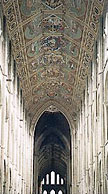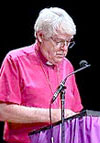
|
||
|
|
Basics
Start Here
Anglicans Believe ...
The Prayer Book
The Bible
News
News Centre
News Archive
Newspapers Online
Official Publications
Resources
Resources A to Z, including
Biblical Study
Book of Common Prayer
Books and Magazines
Events
Liturgy
Music
Religious Orders
Preaching
Theology
Youth
Worldwide Anglicanism
Anglican Communion
In Full Communion
Not in the Communion
Dioceses and Parishes
Africa
Australia
Canada
England
Europe
Ireland
Japan
New Zealand
Scotland
USA
Wales
World
Anglicans Online
Add a Site to AO
Tell Us What You Think
Link to AO
About Us
Staff
Awards and Publicity
Beginnings
AO Today
Our Sponsors
Hallo again to all.
This past
Friday we were treated to a once-in-a-lifetime tour of the great
Cathedral at Ely, in Cambridgeshire. In AD 673, when it was founded
as a monastery, Ely was the Isle of Eels, an island in the marshland and
 swamp nearby. Life was frail back then, and the fortunes of the island
monastery waxed and waned, but by 1109, when the Diocese of Ely was formed
by dividing the Diocese of Lincoln, it was the site of a cathedral. We
climbed spiral staircases that were a thousand years old, we walked cautiously
across the lead roof to climb to the stained glass in the lantern, and
we marveled at the Latin writing and Roman numerals still visible on the
timbers as written by the Roman carpenters who built it. You could almost
reach out and touch the intangible that is our apostolic succession. Our
link to the past, our history, helps guide our imperfect human understanding,
via the apostles and their successors, of the Son of God and His message
to us.
swamp nearby. Life was frail back then, and the fortunes of the island
monastery waxed and waned, but by 1109, when the Diocese of Ely was formed
by dividing the Diocese of Lincoln, it was the site of a cathedral. We
climbed spiral staircases that were a thousand years old, we walked cautiously
across the lead roof to climb to the stained glass in the lantern, and
we marveled at the Latin writing and Roman numerals still visible on the
timbers as written by the Roman carpenters who built it. You could almost
reach out and touch the intangible that is our apostolic succession. Our
link to the past, our history, helps guide our imperfect human understanding,
via the apostles and their successors, of the Son of God and His message
to us.
The thrill of seeing and touching something Christian and Anglican that had been preserved for a thousand years was immediately tempered by touring the ground floor of the Cathedral, to see all of the places where it had been smashed and vandalised during the Dissolution. All of the statues, all of the stained glass, all of the physical objects that symbolised the church, were destroyed. In general there has been no attempt to repair the damage, so the broken sconces and smashed stonework were still as the destroyers had left them.
 |
|
|
A few hours later we attended evensong at King's College Cambridge, after which we contemplated the utter non-destruction of the church despite the near-total destruction of many of its most precious artifacts.
Two days later we saw this letter, which the Most Reverend Michael Peers, Archbishop and Primate of the Anglican Church of Canada, asked be read in every parish in Canada today. There is nothing new in this letter; the facts have been known for many weeks, but it is nonetheless a shock. We can imagine that bishops, priests, vergers, and other churchpeople in 16th-century England were as stunned as ACC people are now, but we are confident that the church itself will outlive this and all other attacks on its physical self. That building is not the church: you and I are the church. We are the Body of Christ. That is just a building.
We grieve with our brothers and sisters in Canada. We assure that beloved part of our Anglican Communion of our prayers: we know that they will have yours, as well.
See you next week.
 |
 |
|
| Cynthia
McFarland cmcf@anglicansonline.org |
Brian
Reid reid@anglicansonline.org |
Last updated:
28 May 2000
URL: http://anglicansonline.org